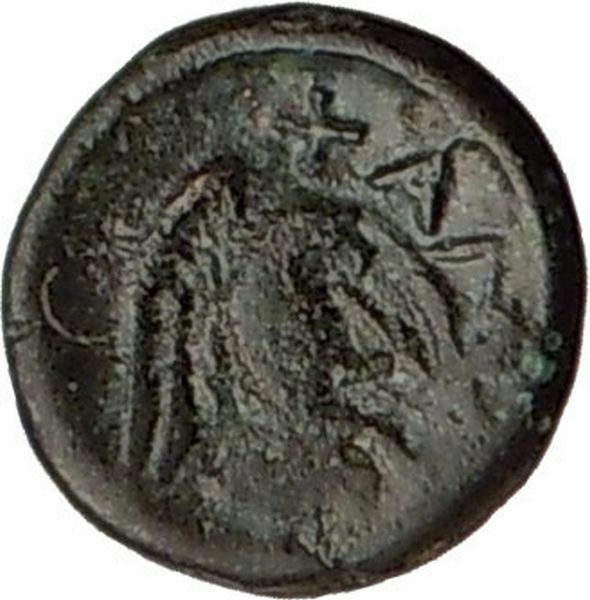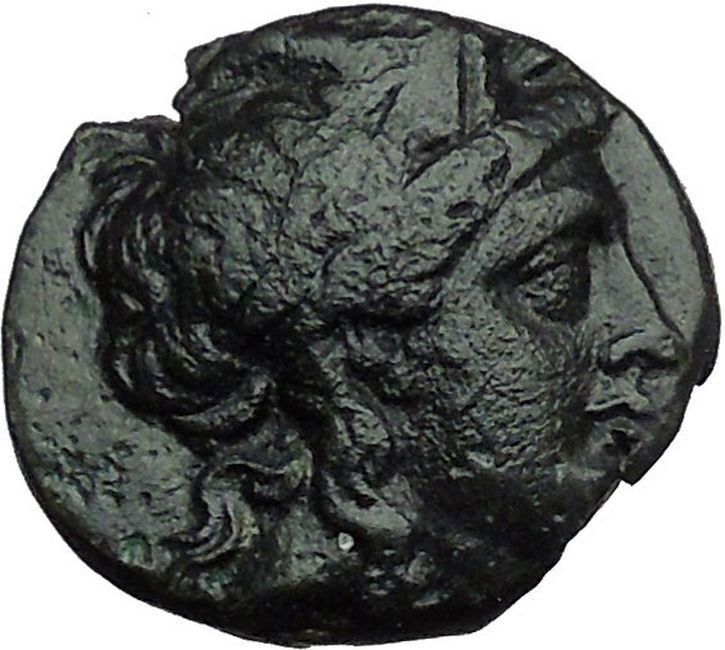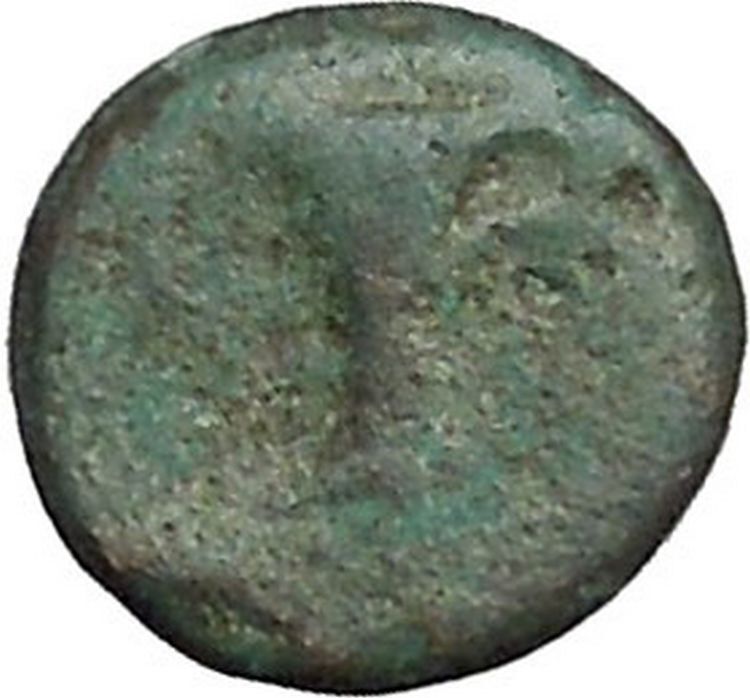|
Greek Coin of
Seleukid Kingdom
Cleopatra Thea
and
Antiochos VIII – Co-rulers: 125-121 B.C.
Bronze
19mm (5.73
grams) Antioch on the Orontes mint, 123-121 B.C.
Reference: HGC 9, 1189; SC 2263
Diademed and radiate head of Antiochos VIII.
ΒΑΣΙΛΕΩΣ ΣHΣ
ΚΛΕΟΠΑΤΡΑΣ ΘΕΑΣ ΚΑΙ ΒΑΣΙΛΕΩΣ ANTIOXOY, Owl standing
facing on fallen amphora.
You are bidding on the exact item pictured,
provided with a Certificate of Authenticity and Lifetime Guarantee of
Authenticity.

In
Greek mythology
, a
Little Owl
baby (Athene noctua)
traditionally represents or accompanies
Athena
, the virgin goddess of wisdom, or
Minerva
, her
syncretic
incarnation in
Roman mythology
. Because of such association,
the bird — often referred to as the “owl
of Athena” or the “owl of Minerva” — has been used as a symbol of
knowledge, wisdom, perspicacity and erudition throughout the
Western world
.
Some authors believe that, in early times, Athena was either an
owl
herself or a
bird goddess
in general: In the third Book of
the Odyssey
, she takes the form of a
sea-eagle
. These authors argue that she dropped
her prophylactic owl-mask before she lost her wings. “Athena, by the time she
appears in art,” Jane Ellen Harrison had remarked, “has completely shed her
animal form, has reduced the shapes she once wore of snake and bird to
attributes, but occasionally in
black-figure vase-paintings
she still appears
with wings.
The
modern West
generally associates owls with
wisdom
. This link goes back at least as far as
Ancient Greece
, where
Athens
, noted for art and scholarship, and
Athena
, Athens’ patron goddess and the goddess
of wisdom, had
the owl
as a symbol.
Marija Gimbutas
traces veneration of the owl as
a goddess, among other birds, to the culture of
Old Europe
, long pre-dating
Indo-European
cultures.
Owls, birds
of the
order
Strigiformes, include about 200
species
of mostly
solitary
and
nocturnal
birds of prey
typified by an upright stance, a
large, broad head, binocular vision and binaural hearing, and feathers adapted
for silent flight. Exceptions include the diurnal
northern hawk-owl
and the gregarious
burrowing owl
. Owls hunt mostly small
mammals
,
insects
, and other birds, although a few
species specialize in hunting
fish. They are found in all regions of the Earth except
Antarctica
and some remote islands. Owls are
divided into two
families
: the
true owls
, Strigidae; and the
barn-owls
, Tytonidae.
Cleopatra Thea (Greek:
Κλεοπάτρα Θεά, which means “Cleopatra the
Goddess”) (c. 164 – 121 BC) surnamed Eueteria (i.e.,
“good-harvest/fruitful season”) was the ruler of the
Hellenistic
Seleucid Empire
. She ruled
the Seleukid Kingdom
from 125 BC after the
death of
Demetrius II Nicator
. She eventually ruled in
co-regency with her son
Antiochus VIII Grypus
, who poisoned her in 121
or 120 BC.
Biography
Cleopatra Thea grew up in Egypt as the daughter of
Ptolemy VI
and
Cleopatra II
. She was probably born ca. 164 BC.
She may have been engaged to her uncle Ptolemy VIII king of Cyrene in 154, but
he eventually married her sister
Cleopatra III
. In 150 BC she married
Alexander Balas
in a sumptuous ceremony at
Ptolemais Akko
. The marriage produced a son
named
Antiochus VI Dionysus
. In 145 BC her father
invaded the Seleukid Kingdom, defeated Alexander Balas in battle and remarried
her to
Demetrius II
, only to die a few days later.
Demetrius set himself up as co-ruler with the young boy Antiochus VI, but may
have killed him in 142 BC.
In 139 BC Demetrius II was captured fighting against the
Parthians
and was held prisoner by them until
129 BC. After Demetrius was captured, his younger brother,
Antiochus VII Sidetes
, who was raised in the
city of Side in Pamphylia, came to the Seleukid Kingdom and took the throne,
marrying Cleopatra Thea in 138 BC. Cleopatra Thea bore him at least one son,
Antiochus IX Cyzicenus
. The names of any other
children are uncertain.
In 129 BC, the Parthians released Demetrius II, as a political manoeuvre
against Sidetes, to claim his throne and his wife. That same year Sidetes was
killed fighting the Parthians. Cleopatra had taken the precaution of sending
Antiochus IX (her son by Antiochus VII) to
Cyzicus
in
Asia Minor
(hence his surname). Demetrius
returned home and regained his throne, taking Cleopatra Thea as his wife by his
side.
In 132/131 BC Cleopatra Thea’s mother, Cleopatra II of Egypt rebelled against
her brother Ptolemy VIII Euergetes II Tryphon. In 127 BC Cleopatra II fled to
her son-in-law Demetrius’ court in the Seleukid Kingdom.
Demetrius’ elder son, Seleucus, became king with the name Seleucus V in 125
BC; however, his mother, Cleopatra Thea, had him murdered soon after. From 125
BC to 121 BC, Cleopatra ruled the Seleukid Kingdom and to legitimize her reign,
she shared the throne with her son,
Antiochus VIII Grypus
. Antiochus VIII was
married to Tryphaena, the daughter of Ptolemy VIII and Cleopatra III.
Grypus became less controllable as he grew up and in 121 BC Cleopatra Thea
decided to eliminate him. As he returned from a hunt one day, she offered him a
cup of wine. Since this was not common behavior for her, Grypus was suspicious
and forced her to drink the wine, which killed her.
Grypus re-organised the state and for the next eight years he provided
stability and financial recovery. This period would end ca. 114 BC, when
Cleopatra Thea’s other son, Antiochus IX Cyzicenus, returned to the Seleukid
Kingdom to claim the throne and civil war started again.
Family
Cleopatra Thea was a daughter of
Ptolemy VI
of Egypt
and
Cleopatra II
. She had two brothers named
Ptolemy Eupator and Ptolemy respectively. Her sister
Cleopatra III
was Queen of Egypt and married to
Ptolemy VIII
, an uncle. It is possible that
Berenice, the fiancee of
Attalus III
, king of
Pergamum
is another sister.
Cleopatra Thea married three times:
- She married
Alexander Balas
(Greek: Ἀλέξανδρος Βάλας)
in about 150 BC. This union produced
Antiochus VI Dionysus
. Alexander Balas was
neither popular, nor an efficient ruler. The marriage was dissolved by her
father. Alexander Balas died in battle against
Demetrius II of the Seleukid Kingdom
in 145
BC.
- Cleopatra Thea married
Demetrius II Nicator
, (Greek: Δημήτριος
Νικάτωρ) in 145 BC. Cleopatra bore him two sons, who later grew up to be
kings:
Seleucus V Philometor
,
Antiochus VIII Grypus
, and possibly a
daughter Laodice. Demetrius became a captive of the Parthians from 139-129
BC. He was assassinated in Tyre in 125 BC at the orders of his wife
Cleopatra Thea.
- Cleopatra Thea married Demetrius’ younger brother,
Antiochus VII Sidetes
in 137 BC after
Demetrius was captured by the Parthians. Cleopatra and Antiochus VII had
several children:
Antiochus IX Cyzicenus
and likely
Antiochus, Seleucus and one or two daughters named Laodice.
Antiochus VIII Epiphanes/Callinicus/Philometor, nicknamed Grypus
(hook-nose), was crowned as ruler of the
Greek
Seleucid kingdom
in 125 BC. He was the son of
Demetrius II Nicator
and
Cleopatra Thea
.
Biography
Antiochus Grypus was crowned as a teenager in 125 BC after his mother
Cleopatra Thea
had killed his elder brother
Seleucus V Philometor
, ruling jointly with her.
After Antiochus defeated usurper
Alexander II Zabinas
in 123 BC his mother tried
to poison him with wine, but the suspicious king forced her to drink the cup
herself. (The story may have been inspired by the fact that Grypus was
interested in toxicology; some poems about poisonous herbs believed to have been
written by him are quoted by the famous physician
Galen
).
Either he or his half brother
Antiochus IX Cyzicenus
is probably identical
with the ephemeral child ruler Antiochus Epiphanes, who was crowned by
Cleopatra Thea
after the death of Antiochus VII
but before Demetrius II returned to Antioch. The child Antiochus Epiphanes, who
is known from coins, was deposed—but not killed—when Demetrius II was restored
in 129 BC.
Coin of Antiochus VIII Grypus. Reverse: god
Sandan
standing on the horned lion,
in his pyre surmounted by an
eagle
.
Despite political shortcomings, Grypus was a popular king. His ugly, lazy
appearance on coins (common among the last Seleucids), together with stories of
his lavish banquets, made posterity believe his dynasty was degenerated and
decadent. This was however a conscious image, an invocation of the Hellenistic
idea Tryphe
– meaning good life, which the last
Seleucids strove to be associated with, as opposed to the exhausting civil wars
and feuds which troubled their reigns in reality.
A story of his luxurious parties claims he sent food home with guests who
attended banquets, complete with a camel as beast of burden, as well as a with
attendant to carry the guest himself. This should certainly have caused some
strain on the already depleted treasury.
Family
He married the
Ptolemaic
princess
Tryphaena
, but in 116 BC his half-brother and
cousin
Antiochus IX Cyzicenus
(see
Antiochus VII Sidetes
) returned from exile and
a civil war
began. Cyzicenus’ wife, also named
Cleopatra
, was a sister of Tryphaena and was
eventually killed in a dramatic fashion in the temple of
Daphne
outside
Antioch
, on the order of Tryphaena. Cyzicenus
eventually killed Tryphaena as revenge. The two brothers then divided
the Seleukid Kingdom
between them until Grypus
was killed by his minister Heracleon in 96 BC.
Five of Grypus’ sons later rose to kingship:
-
Seleucus VI Epiphanes
-
Antiochus XI Ephiphanes Philadelphus
-
Philip I Philadelphus
-
Demetrius III Eucaerus
-
Antiochus XII Dionysus
This contributed to the confusion of civil war amid which the Seleucid empire
ended.
He also had at least one daughter:
-
Laodice VII Thea
, married to king
Mithridates I Callinicus
of
Commagene
as part of a settlement by
Mithridates’ father
Sames II Theosebes Dikaios
to ensure peace
between the Kingdom of Commagene and the
Seleucid Empire
. Laodice and Mithridates’
son was king
Antiochus I Theos of Commagene
. This was a
grandson to Grypus.
Seleucid
Empire
Σελεύκεια
Seleúkeia |

|
312 BC–63 BC |
↓
|
|
|
The Seleucid Empire in 301 BC.
|
The Seleucid Empire
was a
Hellenistic
state ruled by the Seleucid dynasty
founded by
Seleucus I Nicator
following the division of
the empire created by
Alexander the Great
. Seleucus received
Babylonia
and, from there, expanded his
dominions to include much of Alexander’s
near eastern
territories. At the height of its
power, it included central
Anatolia
, the
Levant
,
Mesopotamia
,
Kuwait
,
Persia
,
Afghanistan
,
Turkmenistan
, and northwest parts of
India
.
The Seleucid Empire was a major center of
Hellenistic
culture that maintained the
preeminence of
Greek
customs where a Greek-Macedonian
political elite dominated, mostly in the urban areas. The Greek population of
the cities who formed the dominant elite were reinforced by emigration from
Greece
. Seleucid expansion into
Anatolia
and Greece was abruptly halted after
decisive defeats
at the hands of the
Roman army
. Their attempts to defeat their old
enemy
Ptolemaic Egypt
were frustrated by Roman
demands. Much of the eastern part of the empire was conquered by the
Parthians
under
Mithridates I of Parthia
in the mid-2nd century
BC, yet the Seleucid kings continued to rule a
rump state
from
the Seleukid Kingdom
until the invasion by
Armenian
king
Tigranes the Great
and their ultimate overthrow
by the Roman
general
Pompey
.
|











